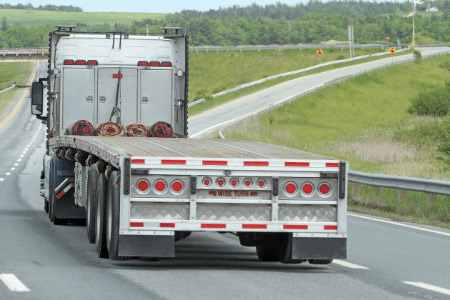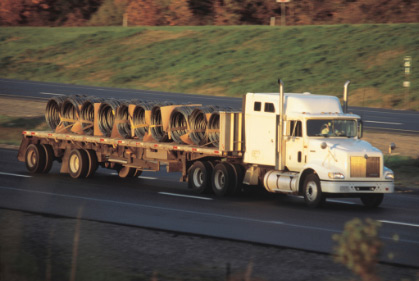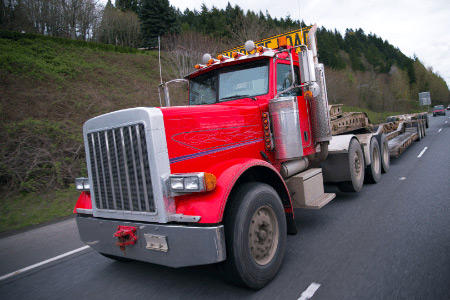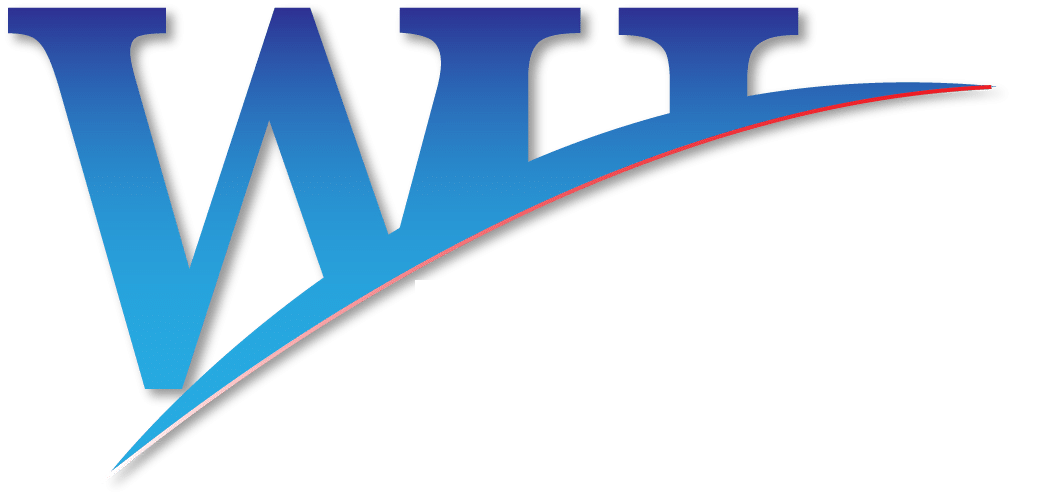Flatbed Shipping
Shipping Freight on a Flatbed
What is a Flatbed Trailer?
Flatbed trailers are an essential part of the shipping industry, a common sight on roads today. Offered in various configurations, flatbeds can be tailored to the commodity, making freight that would otherwise be unmovable, movable. This blog will provide further education on the types of flatbeds and the benefits they offer.

Benefits of Shipping on a Flatbed
Flatbeds are an important aspect of the shipping industry and are used to move freight globally. The following are some of the important benefits that flatbeds offer:
ACCESSIBILITY: The ease of access allows for freight to be loaded without trouble. Freight can be loaded from the back, side and top. This makes loading freight of unconventional dimensions and weight more feasible. Flatbed operators have the expertise to help determine the best strategy when loading freight.
USABILITY: Flatbeds allow for a wider range of usage. Large LTL loads that cannot fit in a dry van can be accommodated easier on a flatbed. Freight is secured using tarps and straps. Flatbeds can come with various different types of tarps. The shipper may pass along recommendations for whether they need want a tarp for their freight or not. Along with this, they may recommend a type of tarp that is commonly used for their shipments. Drivers are trained on proper loading and unloading techniques, ensuring a safe and reliable transportation process.
WIDESPREAD OPTIONS: Flatbeds come in several different types. Some of these include drop deck, step-deck or removable gooseneck. Freight can be matched up with a trailer that offers the proper characteristics for the commodity. Weight and dimensions play a significant factor in the trailer type and it is important to provide the exact numbers to ensure a smooth process.
Durability: Flatbeds are built to last. Due to the types of equipment and materials that are placed on flatbeds, it is important that the trailers are build to take the weight and impact of what they are carrying. Flatbeds take the most abuse of any trailer type and are used to carry some of the heaviest freight in the world.
Common Uses of Flatbeds
Construction
The pandemic has brought a lot of change and has uplifted certain aspects of the economy. The construction industry has grown and with that, high quantities of materials have shipped to job sites. This was a perfect storm for the flatbed industry, which has always put focus on construction-related commodities. The following are some examples of what is shipped on these flatbeds:
- Rebar
- Piping
- Lumber

Automotive
Flatbed trucks are frequently used to move vehicles. The easy access of a flatbed allows vehicles to be driven onto the trailers. Non-operational vehicles can be lifted onto a flatbed using a wheel loader and car forks. Flatbeds also have the weight capacity to handle any non-commercial vehicle.
Heavy Machinery
Flatbeds are a key component in the moving of equipment and heavy machinery. Due to the size and weight of heavy machinery, enclosed trailers are not a viable option. With the help of straps and other loading equipment, machinery can be safely loaded and unloaded.
Oversize Loads

Oversize loads are where flatbed trailers are very important. Some freight is unable to fit into the constraints of the regulations but still needs to be moved. With special approval, flatbed trailers are used to move freight that would usually be too large to move over the road. The most common reason that that freight is considered oversized is due to the width. Anything that passes the 8.5feet wide is considered oversized and shipments that exceed 12 feet wide may require one to two pilot vehicles in front or behind the vehicle. With the various flatbed configurations available, freight that seems unmovable becomes movable, a major benefit of flatbeds.
Superloads
Superloads are similar to and are in the same category as oversize loads but are much larger and come with various approvals and permits in order to occur. A superload passes an oversize load in one or more of height, width, length or weight. They are usually loads of very large equipment or parts that are found on some of the largest vehicles or structures. It is rare to see a superload on the roads but when you do, they are hard to miss.
Flatbed Shipping in Canada
Types of Flatbed Trailers
Standard Flatbed
Standard flatbeds are the most identifiable type. They are a simple flat deck with no special characteristics. They are used to move freight that doesn’t need much protection from the elements.
Standard Dimensions
- Length: 48-53ft
- Width: 8.5ft
- Height: 8.5ft
Extendable Flatbed
Extendable flatbeds offer the same height and width capabilities of a standard flatbed but can be extended up to 80ft. They are designed for freight that is too long to fit on a standard flatbed.
Standard Dimensions
- Length: 48-80ft
- Width: 8.5ft
- Height: 8.5ft
Single Drop Flatbed
Single drop deck, also known as drop deck trailers are flatbeds that have a lowered deck. The reason for this is that they can hold taller freight and still stay within the regulations.
Standard Dimensions
Front Deck:
- Length: 11ft
- Width: 8.5ft
- Height: 8.5ft
Lowered Deck:
- Length: 37ft
- Width: 8.5ft
- Height: 10ft
Extendable Single Drop Flatbed
Extendable single-drop trailers are designed for freight that is too long for a standard length step deck. The main deck of a single drop extended flatbed can be stretched to 63ft.
Standard Dimensions
Front Deck:
- Length: 10ft
- Width: 8.5ft
- Height: 8.5ft
Main Deck
- Length: 35-63ft
- Width: 8.5ft
- Height: 10ft
Double Drop Flatbed
The double drop trailer is very similar to a single drop trailer but as the name suggests, has two drop points. The first drop is after the gooseneck, the second before the back wheels. Sometimes referred to as lowboy trailers, due to how low they can be to the ground, allowing for maximum height capabilities.
Standard Dimensions
Front Deck:
- Length: 10ft
- Width: 8.5ft
- Height: 8.5ft
Main Deck:
- Length: 25-29ft
- Width: 8.5ft
- Height: 11.5ft
Rear Deck:
- Length: 9ft
- Width: 8.5ft
- Height: 10ft
Extendable Double Drop Flatbed
Extendable double drop trailers are designed for freight that needs a higher clearance but is too long to haul on a standard double drop trailer. The main deck of a single drop extended flatbed can be stretched to 50ft.
Standard Dimensions
Front Deck:
- Length: 10ft
- Width: 8.5ft
- Height: 8.5ft
Main Deck
- Length: 29-50ft
- Width: 8.5ft
- Height: 11.5ft
Rear Deck
- Length: 9ft
- Width: 8.5ft
- Height: 10ft
Removable Gooseneck Trailers (RGN)
Removable gooseneck trailers are a key component of the heavy hauling industry. The front of the trailer detaches, creating a ramp for loads to be driven onto the trailer. RGN trailers can be configured with 20x axles, meaning they can carry freight up to 150,000 pounds.
Standard Dimensions
Front Deck:
- Length: 10ft
- Width: 8.5ft
- Height: 8.5ft
Main Deck:
- Length: 29ft
- Width: 8.5ft
- Height: 11.5ft
Rear Deck:
- Length: 9ft
- Width: 8.5ft
- Height: 10ft
Stretch Removable Gooseneck Trailers
The stretch removable gooseneck trailer is designed to carry loads that are too long for a standard length RGN. Stretch RGN’s are used to haul some of the heaviest loads on the road today, with some carrying over 150,000 pounds. Axles on a stretch RGN range from 3 to 20+ with the number being dependent on the weight of the freight.
Standard Dimensions
Front Deck:
- Length: 29-65ft
- Width: 8.5ft
- Height: 11.5ft
Conclusion
The importance of flatbeds in the transportation industry is almost immeasurable. They provide solutions to many issues and are at the heart of various industries globally. The equipment and materials that are transported on flatbeds are used for the continuous development of our cities today. In Canada, they play a vital part in connecting businesses, country wide. The impressive lineup of flatbeds and the segments that each one targets give companies the ability to move freight efficiently that would otherwise be extremely difficult to move.
At Wood-Hall Logistics, we have always enjoyed moving freight on a flatbed. We always ensure that we connect your shipment with the right type of flatbed and the right company for the job. We thank you for your time and we are always open to answer any questions. Reach out to us today through operations@wood-hall.com or give us a call at 519-213-1000!
-The Team at Wood-Hall Logistics

